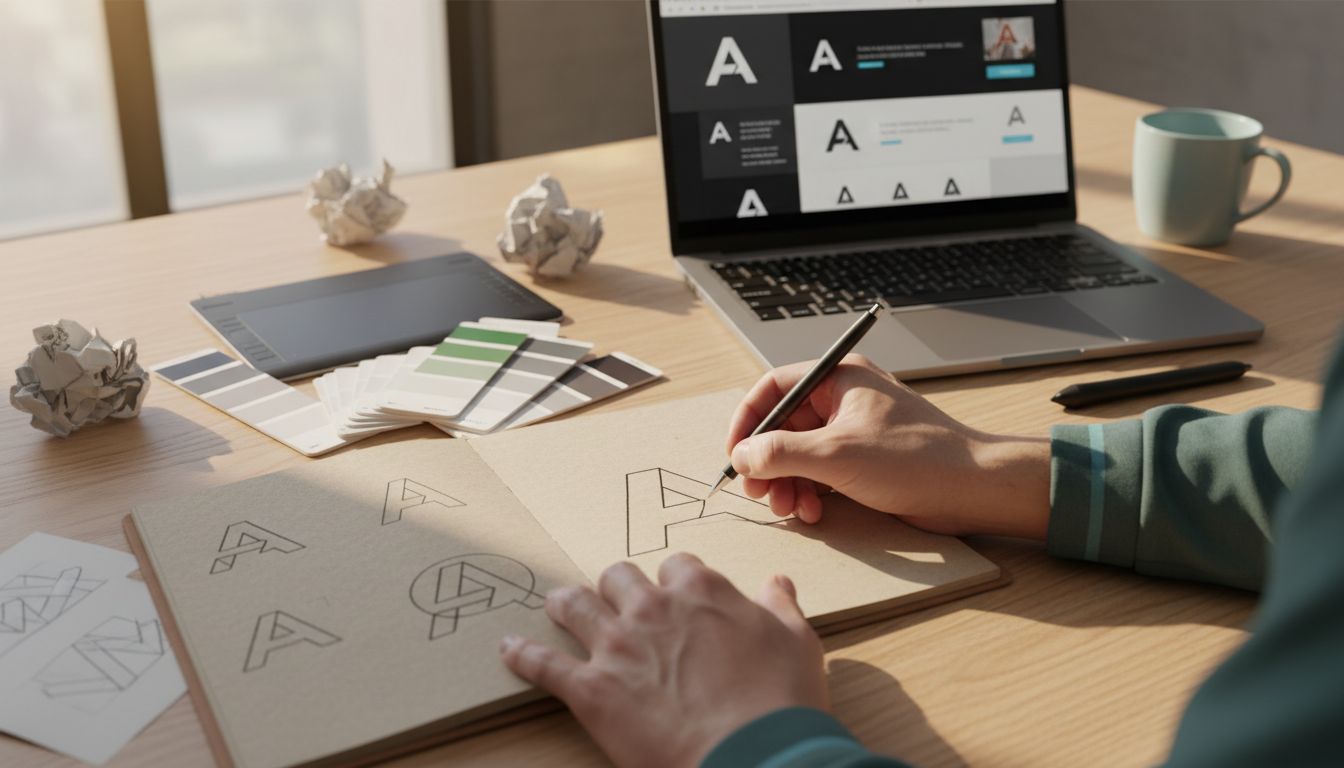Strong branding shapes business success, yet over 60 percent of south-african businesses struggle to define their brand identity clearly. In a crowded market, a great logo does far more than look appealing. It can inspire trust, set you apart, and tell your story in a single glance. This guide unpacks the principles and key elements behind effective logo design, helping south-african brands create visuals that leave a lasting impression where it matters most.
Table of Contents
- Defining Logo Design Principles
- Types of Logos and Their Uses
- Essential Elements of Effective Logos
- Brand Identity and Visual Consistency
- Common Logo Design Mistakes to Avoid
Key Takeaways
| Point | Details |
|---|---|
| Simplicity | A successful logo should be clean and uncomplicated to ensure instant recognition. |
| Memorability | Logos must be unique enough to stick in the minds of viewers, creating a lasting impression. |
| Versatility | It’s important for a logo to maintain its effectiveness across various platforms and sizes. |
| Timelessness | Good logo design should transcend current design trends to remain relevant over time. |
Defining Logo Design Principles
A logo represents the visual cornerstone of a brand’s identity, serving as the immediate visual representation that communicates an organisation’s essence in a single glance. According to teachrock.org, effective logo design hinges on five fundamental principles that transform a simple graphic into a powerful communication tool.
The core principles of logo design encompass several critical dimensions that determine a logo’s effectiveness and impact. As highlighted by canva.com, these principles include:
- Simplicity: Creating a clean, uncomplicated design that allows instant recognition
- Memorability: Crafting a unique visual element that remains etched in viewers’ minds
- Versatility: Designing a logo that maintains its integrity across multiple platforms and scales
- Timelessness: Developing a visual identity that remains relevant beyond current design trends
- Appropriateness: Ensuring the logo resonates with the specific target audience and brand personality
Understanding these principles goes beyond aesthetic considerations; they represent strategic decisions that directly influence brand perception. A well-designed logo communicates professionalism, builds trust, and creates an immediate emotional connection with potential customers.
 For businesses seeking to develop a compelling visual brand identity, mastering these logo design principles becomes crucial. Check out our additional insights in the 7 Tips to Keep in Mind While Designing a Brand Logo article to deepen your understanding of effective logo development.
For businesses seeking to develop a compelling visual brand identity, mastering these logo design principles becomes crucial. Check out our additional insights in the 7 Tips to Keep in Mind While Designing a Brand Logo article to deepen your understanding of effective logo development.
Types of Logos and Their Uses
Designing an effective logo requires understanding the various logo types that can communicate a brand’s unique identity. According to learn.leighcotnoir.com, there are five primary logo categories, each with distinct characteristics and strategic applications that businesses can leverage to create memorable visual representations.
The five main logo types include:
- Brand Marks: Pure symbolic or iconic representations that visually communicate a brand’s essence without text
- Word Marks: Text-based logos using distinctive typography to spell out the company or brand name
- Letter Marks: Logos constructed using abbreviated initials or strategic letter combinations
- Combination Marks: Designs integrating both text and symbolic elements for comprehensive brand storytelling
- Emblems: Enclosed logos where text is integrated within a graphic container or shape
Each logo type offers unique advantages for different brand communication strategies.
Word marks work brilliantly for companies with memorable names, while brand marks provide universal recognition across language barriers. Combination marks offer flexibility, allowing businesses to communicate both visual and textual brand messaging. When selecting a logo type, consider your brand’s personality, target audience, and long-term visual communication goals. For more insights into creating impactful visual identities, explore our guide on The Most Recognisable Logos in the World to understand how successful brands leverage different logo approaches.
Essential Elements of Effective Logos
Creating a powerful logo requires more than aesthetic appeal; it demands strategic design that communicates a brand’s core identity. According to teachrock.org, effective logos are built on five critical elements that transform a simple graphic into a compelling brand representation.
The essential elements of a successful logo include:
- Simplicity: Designing clean, uncluttered visuals that communicate instantly
- Memorability: Crafting a unique visual signature that leaves a lasting impression
- Versatility: Ensuring the logo functions seamlessly across multiple platforms and contexts
- Timelessness: Creating a design that remains relevant beyond current design trends
- Appropriateness: Aligning the visual identity with the brand’s core personality and target audience
Beyond these foundational principles, successful logo design requires a nuanced understanding of visual communication. Canva.com emphasizes that a truly effective logo must be recognizable, adaptable, and authentically representative of the brand’s unique narrative. Colour psychology, typography, and visual balance play crucial roles in creating a logo that not only catches the eye but also communicates a brand’s deeper values and personality. For deeper insights into how logos impact brand perception, explore our detailed analysis in The logo design and its impact on brand consumption, which unpacks the strategic dimensions of visual branding.
![]()
Brand Identity and Visual Consistency
Brand identity is the visual and emotional fingerprint that distinguishes an organisation from its competitors. According to learn.leighcotnoir.com, the strategic selection of logo types plays a crucial role in establishing a cohesive and recognisable brand presence across multiple platforms and touchpoints.
Key components of maintaining visual consistency include:
- Logo Selection: Choosing a logo type that authentically represents the brand’s core values
- Colour Palette: Developing a consistent colour scheme that evokes the right emotional response
- Typography: Selecting fonts that communicate the brand’s personality
- Visual Language: Creating a unified visual approach across all brand materials
- Application Flexibility: Ensuring the logo adapts seamlessly across different mediums
Effective brand identity goes beyond mere visual elements. It requires a holistic approach that integrates design choices with the brand’s strategic narrative. Consistency becomes the cornerstone of building brand recognition, trust, and emotional connection with the target audience. When every visual touchpoint tells a coherent story, businesses create a powerful and memorable brand experience. For a deeper understanding of building a compelling brand identity, explore our comprehensive guide on What is Brand Identity? Understanding Its Significance, which provides invaluable insights into creating a distinctive and impactful brand presence.
Common Logo Design Mistakes to Avoid
Creating a compelling logo demands precision and strategic thinking. According to Canva.com, many businesses fall into predictable traps that compromise their visual brand identity, ultimately undermining their market positioning and brand perception.
The most critical logo design mistakes include:
- Overcomplication: Cramming too many design elements that dilute the core message
- Trend Chasing: Designing logos that look dated within months instead of years
- Poor Colour Selection: Choosing colours that clash or fail to reflect brand personality
- Lack of Versatility: Creating logos that don’t scale or work across different platforms
- Ignoring Brand Context: Developing designs disconnected from the brand’s core values
As teachrock.org emphasizes, successful logos prioritize simplicity, memorability, and timelessness. Professional designers understand that a logo is more than a visual mark—it’s a strategic communication tool that must resonate across various contexts and audiences. When businesses overlook these fundamental principles, they risk creating forgettable or confusing brand representations. For more insights into avoiding common branding pitfalls, explore our comprehensive guide on 7 Branding Mistakes to Avoid for Business Growth, which provides actionable strategies for building a robust visual identity.
Elevate Your Brand with Expert Logo Design and Seamless Digital Solutions
Struggling to craft a logo that truly captures your brand’s personality while ensuring simplicity, memorability, and versatility? This guide highlights the vital principles every business must embrace to create a timeless and effective logo that stands out and connects deeply with your audience. Understanding and applying these fundamentals can feel overwhelming but are essential to building strong brand identity and visual consistency.
At Cloud Fusion, we bridge the gap between strategic branding and technical excellence. Our dedicated team specialises in creating bespoke logos that embody your brand’s core values and deliver that emotional connection your audience craves. Combine this with our scalable web development services, and you gain a powerful digital presence that reflects your brand consistently across every platform. Start transforming your visual identity today by requesting a custom web design and development quotation. Don’t wait to make your mark. Visit Cloud Fusion’s website now and discover how our full-service solutions can take your brand to new heights.
Frequently Asked Questions
What are the key principles of effective logo design?
The key principles of effective logo design include simplicity, memorability, versatility, timelessness, and appropriateness. These principles ensure that a logo effectively communicates a brand’s identity and resonates with its target audience.
What types of logos are there?
There are five main types of logos: brand marks (icons), word marks (text-based), letter marks (initials), combination marks (text and symbols), and emblems (text within a graphic). Each type serves different branding strategies.
How can I ensure my logo is versatile?
To ensure your logo is versatile, it should be designed to function well across various platforms and sizes, from business cards to billboards. A logo should still be recognizable and maintain its integrity in different contexts.
What common mistakes should I avoid when designing a logo?
Common mistakes to avoid when designing a logo include overcomplicating the design, chasing trends, poor colour selection, neglecting versatility, and ignoring brand context. Keeping the design simple and aligned with brand values can help create an effective logo.
Recommended
- 7 Tips to Keep in Mind While Designing a Brand Logo
- 7 Key Visual Branding Elements Every Business Needs
- 7 Hacks to Get the Most Out of Your Brand Logo
- What is Brand Identity? Understanding Its Significance
- How to Design Business Signs That Boost Visibility -
- 7 Essential Signage Design Tips for Business Success -








